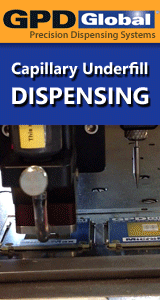Mike: I�d hate to see you making design decisions, based solely on the discussion here, but that this would be an impetus to consult IPC-D-279, "Design Guidelines ... " and take a course on designing reliable boards. Werner Engelmaier (Engelmaier@aol.com) conducts one such course.
Generally, the higher the glass with transition temperature (Tg), the lower the coefficient of thermal expansion (CTE or some times TCE) in the temperature region that boards see during processing. Differences between FR-4 and FR-5 are:
� Tg: FR-4 - 120-135�C. FR-5 - 150-180� C. � Machinability: FR-5 is a bit harder to machine than FR-4. � Max operating temperature: FR-4 - 130�C. FR-5 - 170�C. � Electrical properties: Nearly identical � Some physical properties are significantly different. For instance: - Solder float test value: FR-5 has about 2 times the tolerance of FR-4 - Dimensional stability: FR-5 is superior to FR-4. � FR-5 can meet many of the tough requirements for military and commercial high density SMT applications.
Below Tg, epoxy is rigid with a high modulus. When a board is heated below Tg, the TCE mismatch between the copper barrel and epoxy substrate produces elastic (and plastic) strain in the barrel. However, when the temperature rises above Tg, the epoxy modulus drops and the elastic stress in the barrel begins to compress the substrate. This contracts the barrel and deformed the epoxy in the neighborhood of the barrel.
At soldering temperatures the epoxy is way above its Tg, is very soft, and should be considered a high-viscosity liquid. So, the board can be viewed as a soft substrate with rivets (vias and PTHs) that compress local areas causing the surface to puff up between the rivets. Under these conditions:
� Even though the epoxy tries to expand in all directions, it is constrained in the x, y-directions by the glass reinforcements. � So, the primary expansion is in the z-direction at roughly 3 times the linear thermal expansion, because all the volumetric expansion is funneled into the z-direction. � Additionally, the pin through hole (PTH) (or via hole) allows the epoxy to expand into the space occupied by the PTH, if the barrel wall is thin enough to be compressed. That�s why in cross-sections of PTHs with less than 0.001 inch of copper plating show the PTH barrel bowed inward between inner layer lands. � And the PTH barrel is in tension in the z-direction, with the largest stresses near the PWB center, the PTH barrel experiences compressive hoop stresses, inner layer lands experience tensile stresses at their attachment to the PTH barrel. � If that wasn�t enough, lands on outer layers tend to bend up. This "hinge" effect is the source of the fatigue failure that leads to interface cracks during thermal cycling above Tg.
For double sided designs:
1) Tg 125�C minimum. Minimum PTH copper thickness is 0.001 inch.
For multilayer designs;
1) Tg 135�C minimum. Higher can be used - supplier's choice. 2) Where laminate Tg used is less than 200�C AND overall thickness is greater than or equal to 0.093 inch, minimum PTH copper thickness is 0.0015 inch minimum PTH copper. 3) For all other designs (i.e. thickness less than 0.093 inch, Tg greater than 200�C), minimum PTH copper thickness is 0.001 inch. 4) More assembly heat critical designs have a "plating taper less than or equal to 70%" specification. Where, plating taper as plating thickness at PTH knee to plating thickness at PTH center.
Good luck
Dave F
reply »
![]() Regarding glass transition , does anyone have expierance gl...
- Jan 20, 2000
by
Mike Naddra
Regarding glass transition , does anyone have expierance gl...
- Jan 20, 2000
by
Mike Naddra
![]()
![]()
![]() Mike: I�d hate to see you making design decisions, based s...
- Jan 21, 2000
by
davef
Mike: I�d hate to see you making design decisions, based s...
- Jan 21, 2000
by
davef
![]()






